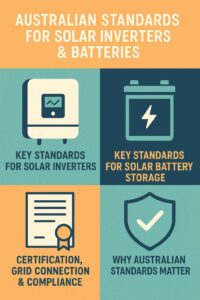As demand for reliable renewable energy grows, understanding which Australian Standards apply to solar inverters & batteries is vital for property owners, designers & accredited installers. These standards ensure systems meet safety, performance & grid compliance requirements, supporting long-term efficiency & eligibility for government incentives in Perth.
Key Standards for Solar Inverters
The main standard for grid-connected inverters is AS/NZS 4777.2:2020 – Grid Connection of Energy Systems via Inverters. This sets minimum performance & safety requirements for inverters connected to electricity distribution networks. It covers anti-islanding protection (automatic shutdown if the grid fails), voltage & frequency response, power factor, & quality of electricity supplied back to the grid.
AS/NZS 4777.1:2016 – Installation Requirements details how inverters must be installed, commissioned & maintained to meet distribution network service provider (DNSP) requirements. Installers must ensure correct system sizing, cable selection, overcurrent protection, labelling & site isolation for maintenance.
All approved inverters must appear on the Clean Energy Council (CEC) approved product list. Using an inverter not on this list can void warranties, lead to grid connection refusal, or impact feed-in tariff eligibility.
Additional Standards Relevant to Solar Inverters
Installers should also apply AS/NZS 3000:2018 (Wiring Rules), which covers general electrical installation practices, including earthing, circuit protection, cabling & weatherproofing. For inverters installed outdoors, IP rating & UV-resistant cabling must comply with relevant clauses of AS/NZS 3000.
If battery storage is integrated, inverters must comply with AS/NZS 5139:2019, which directly impacts hybrid & battery-ready inverter design. Hybrid inverters must be compatible with specified battery chemistries & capable of safe operation during grid outages if backup is provided.
Key Standards for Solar Battery Storage
AS/NZS 5139:2019 – Safety of Battery Systems for Use with Power Conversion Equipment outlines design, installation & safety requirements for solar battery energy storage systems (BESS). It covers system design, placement (indoor/outdoor), enclosure requirements, fire separation distances & ventilation.
Key safety measures include:
- Clearances from habitable rooms & exits.
- Restrictions on installation in high-risk locations (e.g. under stairs).
- Minimum fire-resistance construction where batteries are installed indoors.
- Signage requirements to warn emergency services about stored energy.
Installers must follow manufacturer instructions in line with AS/NZS 5139 & verify that batteries & their integrated battery management systems (BMS) meet product certification requirements.

Certification, Grid Connection & Compliance
Property owners must use a CEC-accredited designer & installer for systems with Solar inverters Perth wide. This guarantees compliance with CEC Installation Guidelines & DNSP conditions. After installation, the installer provides:
- A Certificate of Compliance Electrical Work (CCEW) or equivalent.
- A signed CEC Grid Connect System Design & Install Report.
- Any required DNSP connection approval documents.
For Solar battery Storage Perth, the installation must pass electrical safety inspections where applicable. Some states mandate notification to fire services when installing large-capacity batteries. Incorrect installation or failure to comply with standards can result in fines, insurance issues or denied warranty claims.
Why Australian Standards Matter
Non-compliant installations put homes & occupants at risk of electrical faults, fire hazards or grid instability. Following Australian Standards:
- Protects homeowners from liability & unsafe installations.
- Ensures eligibility for government rebates & feed-in tariffs.
- Supports the long-term performance of solar systems.
- Minimises risks during emergency services response.
For ongoing compliance, system owners should have solar inverters & batteries serviced regularly, keeping records of maintenance, inspections & any component upgrades.
Conclusion
Meeting Australian Standards for solar inverters & battery storage is not optional — it is a legal obligation that safeguards safety, performance & your investment. To ensure your system is designed & installed to full compliance, Southside Solar is the best company for all solar needs in Perth, providing trusted solutions backed by licensed, accredited professionals.

